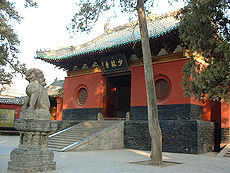- Chāquán
-
Part of the series on
Chinese martial artsList of Chinese martial arts Terms Historical places - Shaolin Monastery (少林寺)
- Wudang Mountains (武當山)
- Mount Hua (華山)
- Mount Emei (峨嵋山)
- Kunlun Mountains (崑崙山)
Historical people - Five Elders (五祖)
- Yim Wing-chun / Yan Yongchun (嚴詠春)
- Hung Hei-gun / Hong Xiguan (洪熙官)
- Fong Sai-yuk / Fang Shiyu (方世玉)
- Dong Haichuan (董海川)
- Yang Lu-ch'an (楊露禪)
- Wu Quanyou (吳全佑)
- Ten Tigers of Canton (廣東十虎)
- Chen Fake (陳發科)
- Chan Heung / Chen Xiang (陳享)
- Wong Fei-hung / Huang Feihong (黃飛鴻)
- Sun Lu-t'ang (孫祿堂)
- Huo Yuanjia (霍元甲)
- Yip Man / Ye Wen (葉問)
- Wang Zi-Ping (王子平)
- Bruce Lee / Li Xiaolong (李小龍)
- Jackie Chan / Cheng Long (成龍)
- Sammo Hung / Hong Jinbao (洪金寶)
- Yuen Biao / Yuán Biāo (元彪)
- Jet Li / Li Lian Jie (李連杰)
- Donnie Yen / Zhēn Zǐdān (甄子丹)
Legendary figures - Bodhidharma / Putidamo / Damo (菩提達摩)
- Zhang Sanfeng (張三丰)
- Eight immortals (八仙)
Related Chāquán (Chinese: 查拳; Hanyu Pinyin: Zhāquán) is a Chinese martial art that features graceful movements and some acrobatic aerial maneuvers. Chāquán also includes a large range of weapons.
Chāquán falls under the classification Chángquán (literally "long fist"), a general term for external Northern Chinese martial arts, which are known for their extended, long movements.
Chāquán is associated with the Hui people. One famous master of Chaquan was the famous Wang Zi-Ping (Chinese: 王子平), who was known for his great strength. Other famous modern day masters include Zhang Wenguang, Ma Jinbiao, and Liu Hongchi.
Chāquán is one of the sources of the contemporary wǔshù Chángquán often seen in movies and tournaments. Chaquan is a system that has 6 main weapons(staff, saber, sword, spear, kwandao, hookswords).It emphasizes long range movements and stances combined with speed and power. The style includes many forms, including 10 lines of tantui for basic power training, 10 longer sets of chaquan, and other forms as well.
References
- Wu Bin, Li Xingdong e Yu Gongbao, Essentials of Chinese Wushu, Foreign languages press, Beijing, 1992, ISBN 7-119-01477-3
- Carmona José, De Shaolin à Wudang, les arts martiaux chinois, Gui Trenadiel editeur . ISBN 2-844445-085-7
External links
Categories:- Chinese martial arts
- Contemporary wushu
- Martial arts stubs
Wikimedia Foundation. 2010.

